Best Practice for Work Intake (Demand Management)
Work Intake (Demand Management) Overview and WHY it is important
Work Intake (also known as demand management) is perhaps the most critical component of project portfolio management because it determines the composition of the portfolio (in terms of quality, value, balance, and resource utilization). Organizations with a broken work intake process will have a compromised project portfolio and likely suffer from poor project execution. In a previous article we provided a holistic overview of the topic of work intake and in this article we will share our best practices for implementing an effective work intake (demand management) process.
Work intake (demand management) is the process for creating, evaluating, and dispositioning new project requests. Most organizations face the problem of having far more demand for new projects than they have the budget or resources to take on those projects. Work intake is the front door to the project portfolio that helps select the right project work for the organization.
Work Intake Best Practice #1: define what a project is (IN scope and OUT of scope)
The very first task for setting up a work intake (demand management) process is to determine the organizational definition of a project. This definition helps define the scope of the portfolio to determine what work could be in the scope of the project portfolio or out of scope for the project portfolio. We can simplify this by defining the different between project work and non-project work (also known as operational work, “business as usual”, “keep the lights on” work, etc.). Without this definition firmly in place and well communicated, a project management team (PMO) will waste time reviewing requests that do not count as project work.
This definition goes beyond the traditional definition of a project where the work is time-bound, defined scope, etc. It is important that the criteria incorporate at least some of the following elements: project size (determined by cost, hours of effort, number of people involved, etc.), level of complexity (technical complexity, type of work requested, number of cross-functional teams involved, etc.), project value (business value, financial value, etc.), and other risk factors (resource risk, organizational change impact, reputational risk, etc.).
Work Intake Best Practice #2: define project tiers to improve demand management
Organizations will do even better if they distinguish different tiers of projects. The reason for doing this is to triage projects that are simpler, shorter, and less risky from the larger projects that need more scrutiny. Utilizing the same review process for all types of projects often results in an unnecessarily burdensome process for smaller projects and will be viewed as bureaucratic. The “organizational immune system” will likely reject this bureaucracy, and the intake process will fail. Utilizing at least two project tiers allows the lower tier to be a ‘fast track’ process for smaller, lower budget, less risky projects. This will greatly improve organizational change management and help the company successfully adopt the intake (demand management) process.
In addition to improving user adoption, there are several other benefits to defining project tiers.
- Work management: utilizing a tiered approach can make it easier to identify who should be managing the work. Projects with shorter duration, lower risk, lower complexity can be managed by junior Project Managers. This can be a great way to develop your project teams by assigning projects to them that fit their skill set.
- Deliverables: by utilizing project tiers, it is easy to communicate what project deliverables are expected of the team. Focus on ‘right-sizing’ the process so that shorter and simpler projects only complete the most important deliverables. Larger and riskier projects can complete more deliverables in order to conclude their due diligence. Best practice #4 will cover right-sizing your process.
- Governance: a tiered project approach can also help define which governance body will be responsible for reviewing, scoring/prioritizing, and approving the work. Best practice #6 will cover tiered governance in more detail.
The table below summarizes this approach with a generic example.
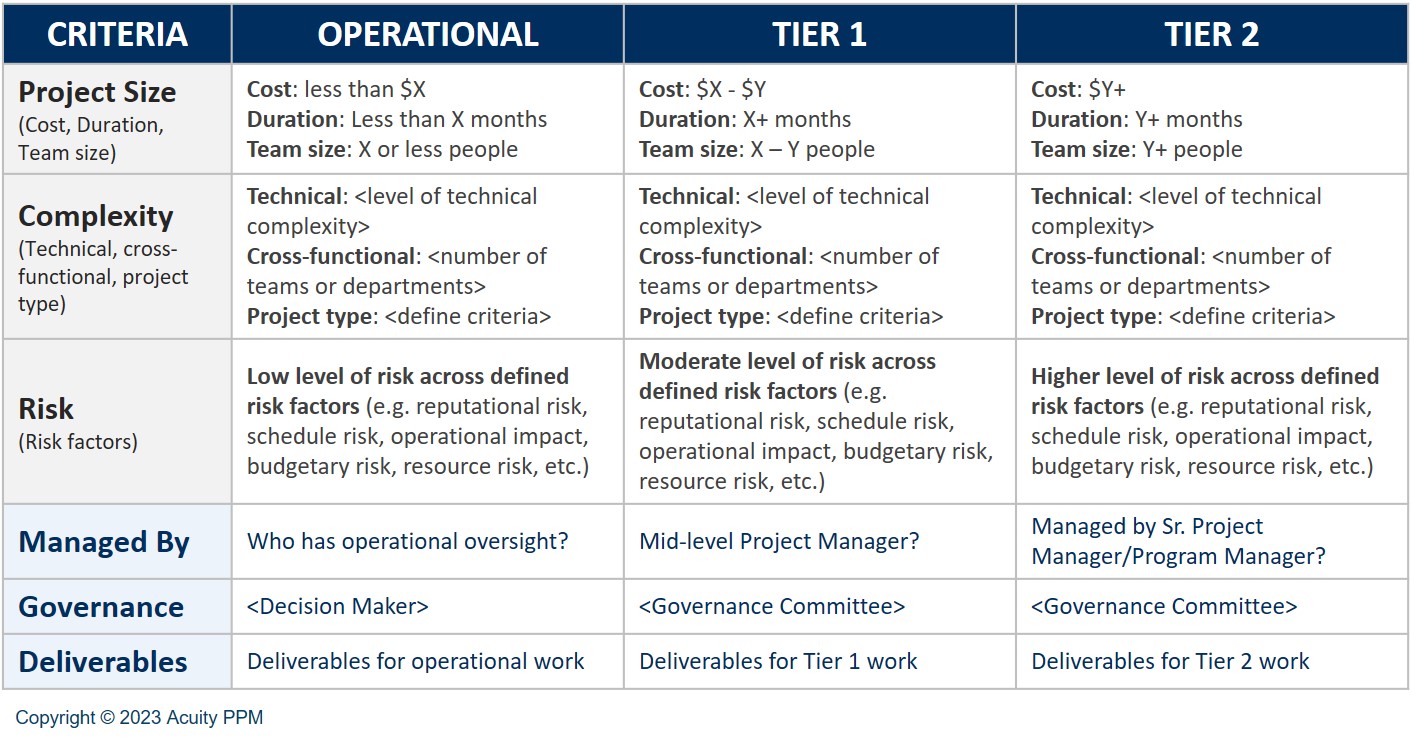
Work Intake Best Practice #3: define what information is most critical to leadership
Another important best practice with setting up a work intake (demand management) process is to define the critical information needed by the governance to make a decision. Do not misunderstand this to mean “define all the information requested by the governance team”. Rather, you need to focus on collecting the most critical and minimal amount of information needed to make a good decision.
The problem that many organizations make is to require a lot of information to be collected by project teams at each decision point in the intake/demand management process (especially true for Phase-Gate processes). This is a common pitfall. Data collection is not free – any data collected but not actively used by the leadership team is an organizational drain of resources. In fact, the more information that gets collected, the less likely that each member of the governance team will read and digest all of that information. We would like to believe that all of the great information that the project team labored to compile will be utilized and considered to make the best strategic decision. In reality, approval decisions are typically made based on a limited set of data (e.g. true criticality, budget/effort, resource availability, and goal alignment). Giving senior leaders all the extensive background details, detailed market analysis, competitor analysis, technology trends, scenario analysis, detailed alternatives, will not likely result in a different decision if the request does not already fit budgetary and resource constraints.
**Pro Tip: ask the governance team what the minimal amount of information is needed for them to make consistently good project decisions. Over time, you can add more requirements to the process if it is determined that requiring more data will truly make the process stronger.
Work Intake Best Practice #4: define the simplest process to prepare for the governance review
Once you have defined the information and deliverables needed to help the governance team to evaluate and score a request in order to make a decision, you now need to define the process for how project teams will collect this information and complete their deliverables. Make the process as easy as possible – reduce the number of touchpoints, provide online forms (as much as possible), limit the number of documents, slides, spreadsheets, etc. Do as much as you can to make it easy for users of the process to make requests and shepherd those requests to the governance team.
The challenge here is to balance the need to keep the process simple AND collect the right data at the right time. Some organizations set up check points to review data collected by the Initiator before going to the governance team. Unfortunately, this results in more meetings and can feel redundant. If you set up quality reviews with project requestors, do so carefully. A good intake process should not feel arduous, but rather should be easy to follow and produce good enough quality data to make a decision. If the process is too complex, people will avoid working with the process and will find ways to go around it.
**Pro Tip: share an example of a completed form that was well done; demonstrate what a “good” completed intake form looks like.
Establishing a “fast track” option is a best practice for work intake (demand management). This option provides a path for smaller and less risky work to get to a decision faster. A fast track intake process will have fewer deliverables, fewer steps, and fewer checkpoints. A lower tiered governance body may review and approve such work.
Work Intake Best Practice #5: incorporate cross-functional reviews
The next work intake best practice corresponds to the previous point but is specific to cross-functional reviews, which involve subject matter experts from various domains to review the proposal and provide feedback. When done well, cross-functional reviews can be very effective at identifying potential risks and issues to a proposed project, uncover unforeseen challenges, address questions related to scope, cost, and resources and help complete the due diligence process. However, when done poorly, cross-functional project reviews result in a seemingly endless set of meetings and hurdles that a Requestor needs to jump through just to submit a request. Be careful to introduce cross-functional reviews only when necessary and only if value is added. Avoid building complex processes that are designed to prevent any possible error or mistake (healthcare is particularly prone to this). Rather, start with a simple process that the organization can adopt and add complexity only when it adds value. Lean process improvement practices can greatly help with developing right-sized processes.
**Pro Tip: Utilize the project tiers to determine which project proposals need a cross-functional review.
Projects that are more expensive, more complex, involve significantly more critical resources should rightly be scrutinized more closely than smaller and simpler projects. For smaller projects, try to conduct reviews over email or meet by exception only when discussion is needed. For larger projects, utilize a checklist to confirm what deliverables are needed for the review so that the meeting can be productive.
The recommendations and endorsements for the proposed project should be shared with the governance team ultimately responsible for approving or rejecting the proposal. Some organizations may allow subject matter experts to veto a project if it potentially violates important criteria that had been agreed to by the governance team.
Work Intake Best Practice #6: right size governance (tiered governance)
Larger organizations that have a good volume of project requests should enable a tiered-governance approach. Tiered governance is about assigning decision rights to different levels of management. For example, proposals that go through the fast-track process might be reviewed by Director-level management, where as larger strategic projects with larger budgets may be reviewed by Executive-level management.
One of the major benefits of this approach is that it frees up Executive leadership to make decisions on the biggest projects undertaken by the company. It’s more than just budget authority, it focused on the strategic direction of the company. If Executive-level leadership is required to review and approve all the small projects in addition to the larger projects, it waters down the entire governance process and hinders portfolio management because so much time is spent reviewing and deciding what work to go forward with. Executive leadership should spend more time on the strategic direction of the company, rather than the lower-level tactics (i.e. small projects). When prioritization is included in the decision making framework, even more time needs to be spent scoring each project, and may not be the best use of time of the Executives. Moreover, Executives just don’t have the time to spend preparing for all the project reviews nor are they close enough to the work to understand many of the details.
Having a lower-level governance team to review smaller projects (likely fast-track projects) offloads work from the Executive team, but still allows for accountability and oversight of the smaller tactical projects. Many of the smaller projects tend to be “run the business” type of projects and are operational in nature, not strategic. Tiered governance also helps train Directors on the disciplines of portfolio management, preparing them for an Executive role in the future.

Work Intake Best Practice #7: empower leadership to say NO
The #1 success factor for any work intake (demand management) process is to say NO to projects that do not belong in the portfolio. This is also the hardest aspect of Intake because most leadership teams say “Yes” to too many projects and overload the portfolio. This is why the Intake/demand management process is so important. Leadership teams that can say no to project requests can help control the flow of work, protect resource capacity, and ensure that the right things are done at the right time. Unfortunately, many leadership teams are inherently bad at saying “No”. Every project has some merit and when reviewed in isolation, that proposal would look like a reasonable request.
I have been in many meetings where there seemed to be a general consensus that it was not the right time to do a project, yet it got approved anyway. There could be many reasons for this: upper management pet project, organizational politics, not wanting to upset people, pressure to get things done, etc.
An effective governance team must be able to say no. In fact, in order to be set up for success, the highest levels of management need to empower the governance teams to say no to work that does not belong in the portfolio. This especially holds true for tiered governance. One of the major pitfalls of utilizing tiered governance is that leaders at the lower tier are not truly empowered to say no to work, because they know that someone will escalate the decision and have it overridden, which really defeats the purpose of governance.
Although not as good as simply cancelling the project, many organizations are utilizing a “no, not right now approach” which means that the project won’t move forward right away, but neither is it cancelled. This is a form of compromise, but may help governance teams work through organizational politics.

**Pro Tip: articulate the decision-making criteria so it is as clear as possible which projects should be approved and which ones should not.
Work Intake Best Practice #8: approve proposals in batches
One of the biggest pitfalls of a work intake process is that too many projects are approved. This stems from the problem that each project in isolation has merit and appears to be worth doing. Moreover, organizations may conduct project reviews on a regular cadence in order to reduce the time that sponsors need to wait for an approval. Although this sounds reasonable, it is in fact a leading root cause for why too many projects are approved.
One of the critical paradigm shifts that leadership needs to make when utilizing project portfolio management is to shift away the singular project view to a holistic portfolio view.
The superior approach (and one of the work intake best practices) is to conduct fewer reviews throughout the year and approve proposals in batches. Why do this? Taking this approach pushes the governance team to review all the alternatives and select the right mix of projects. When several projects need to be reviewed, the governance team should realize that they cannot approve all the requests; there are simply not enough resources to get all of the work done.
One of the critical paradigm shifts that leadership needs to make when utilizing project portfolio management is to shift away the singular project view to a holistic portfolio view. In practice, this means to stop looking at new project requests in isolation and begin looking at the best combination of projects to approve and initiate. By having more projects than can be approved at one time, decision makers are forced to select the best projects for the portfolio. When a governance meeting is held once a week, twice a month, or even once a month, there will be a smaller number of projects to review but the likelihood of approval goes up significantly. When there are fewer project review meetings (such as quarterly), there competition for scare resources goes up and the governance team can select a superior mix of projects than if individual projects were review on a more recurring basis. I used to be a proponent of a more “on demand” and “streamlined” governance by holding governance meetings on a more regular basis, but after seeing a consistently poor result, I highly recommend that organizations review project proposals in larger batches to help force a “portfolio selection view” of work intake.
Work Intake Best Practice #9: incorporate prioritization
Another best practice for work intake (demand management) is to utilize prioritization into the work intake process. We recommend utilizing a weighted scoring model to help the governance team conduct a fair assessment of the proposed project because the scoring output will help inform the governance decision. However, even the use of a priority matrix will enhance work intake. The prioritization exercise does not make the decision but it informs the governance team and helps result in a better decision for the portfolio.

A tool like Acuity PPM can take the scores of the respective projects and visualize this in a risk-value bubble chart, which is a one-page visualization of the portfolio. Having this view can further help the leadership team compose a higher quality portfolio based on the current and proposed projects.
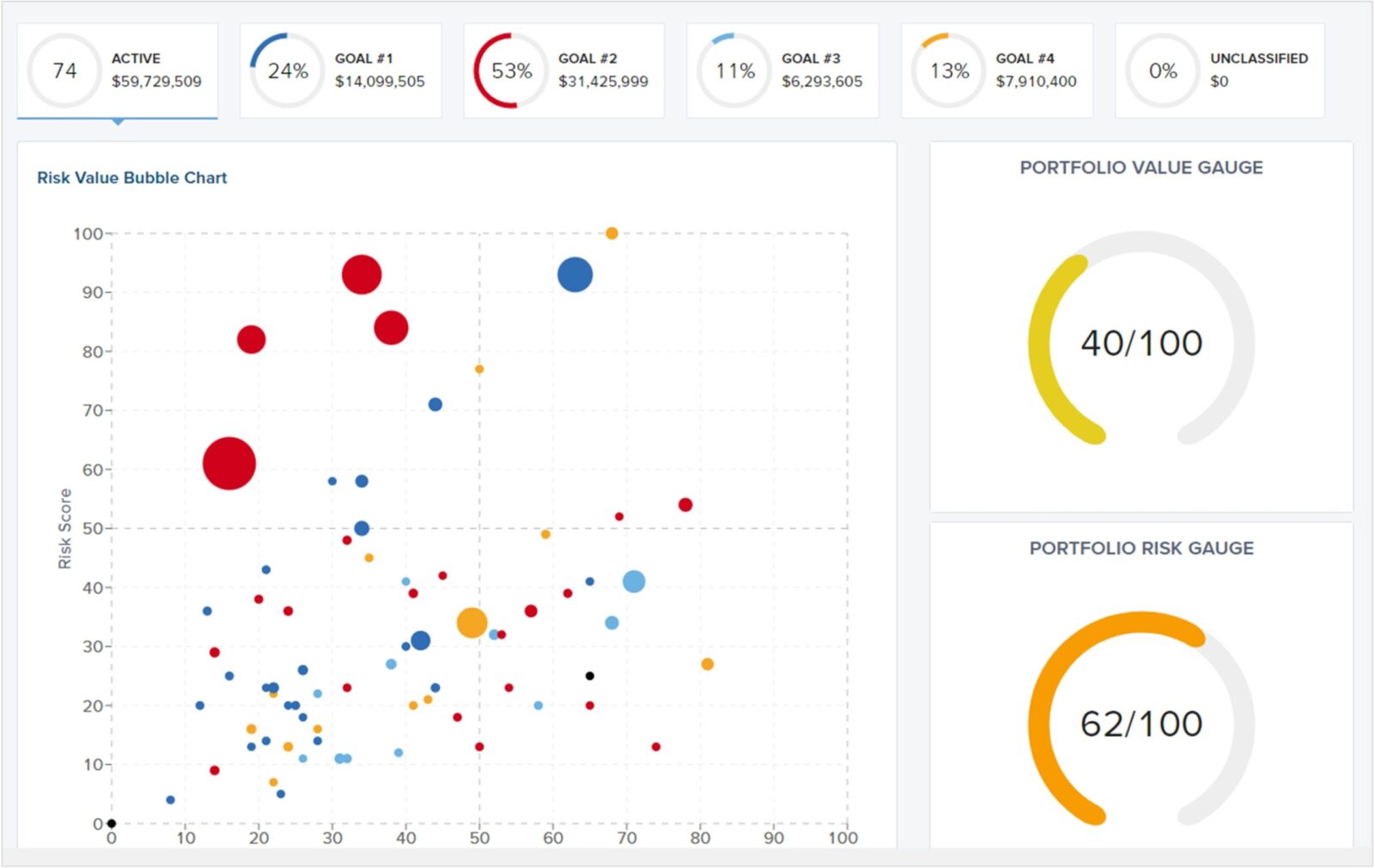
Best Practice #10: incorporate resource management
Another best practice for work intake (demand management) is to incorporate resource forecasts into the decision-making process. Organizations that can forecast resource demand and compare this against existing demand will not only make better decisions but will have more realistic portfolios. The primary reason why approving too many projects is so detrimental to the portfolio is that it causes key teams to be over-utilized and forces individuals to excessively multi-task in order to keep up with work. These two resource factors contribute to project delays, cost overruns, and degraded quality. Protecting resource capacity is an essential function of a portfolio governance team.
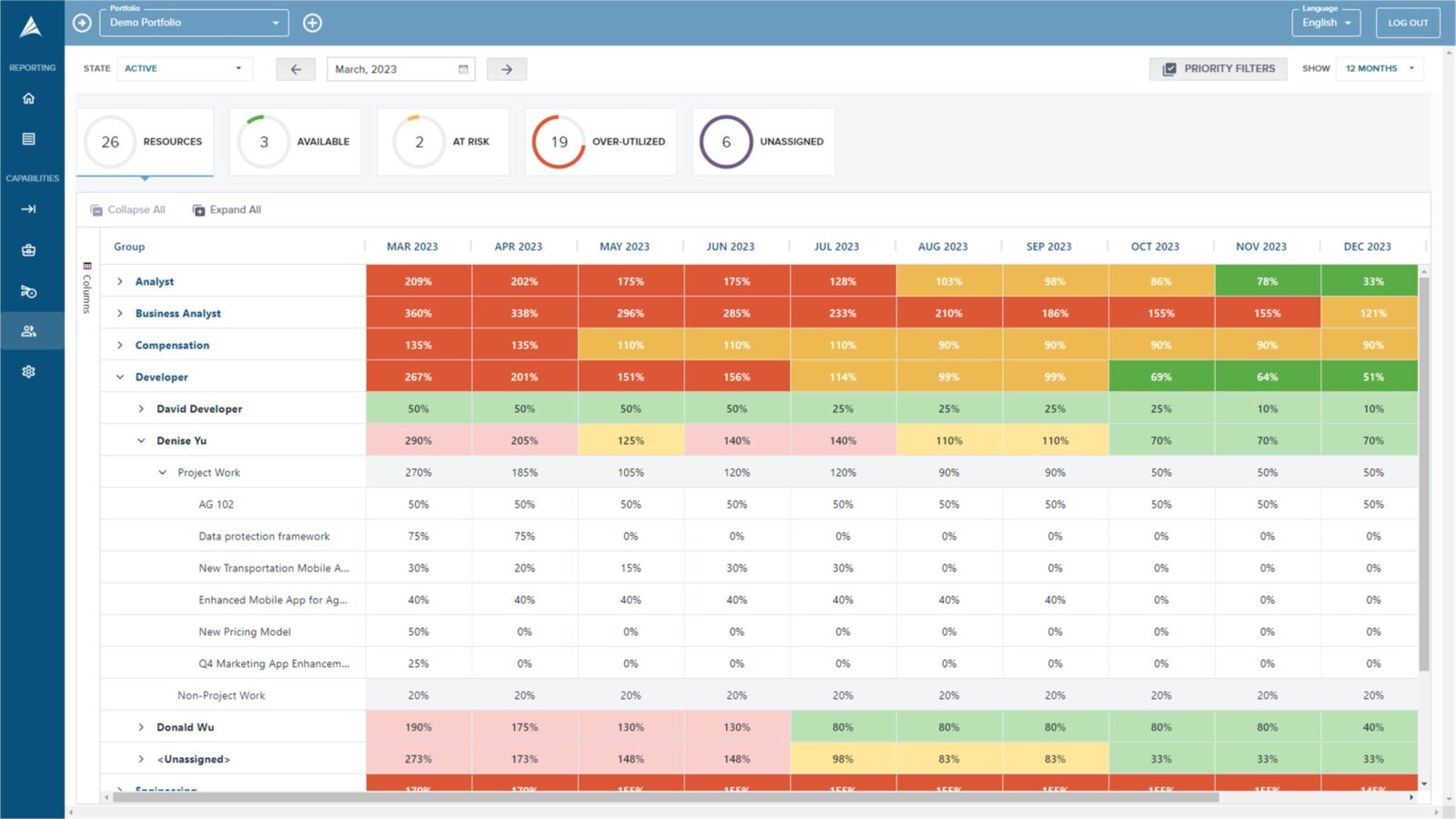
While most of the best practices for work intake (demand management) can be practiced right away, an organization will need to develop resource capacity planning processes before it can be incorporated into their work intake process.
Best Practice #11: communicate the process
Portfolio communication was covered in another article, and one of the points of emphasis was to actively communicate portfolio processes. This is very important when it comes to implementing a work intake (demand management) process because it is one of the few processes that the broader organization may interact with. Sponsors of project portfolio management and Portfolio Managers must sell the business on the intake process and the benefits of utilizing intake, otherwise you will fight an uphill battle to get user adoption of the process. If the intake (demand management) process is not well understood, it will appear to be a black box to the organization. When people understand how to submit new ideas they will be more likely to work within the process and not go around it. However, without adoption, requested projects will go around the process and make it far harder to build a high value portfolio that is realistic to achieve.
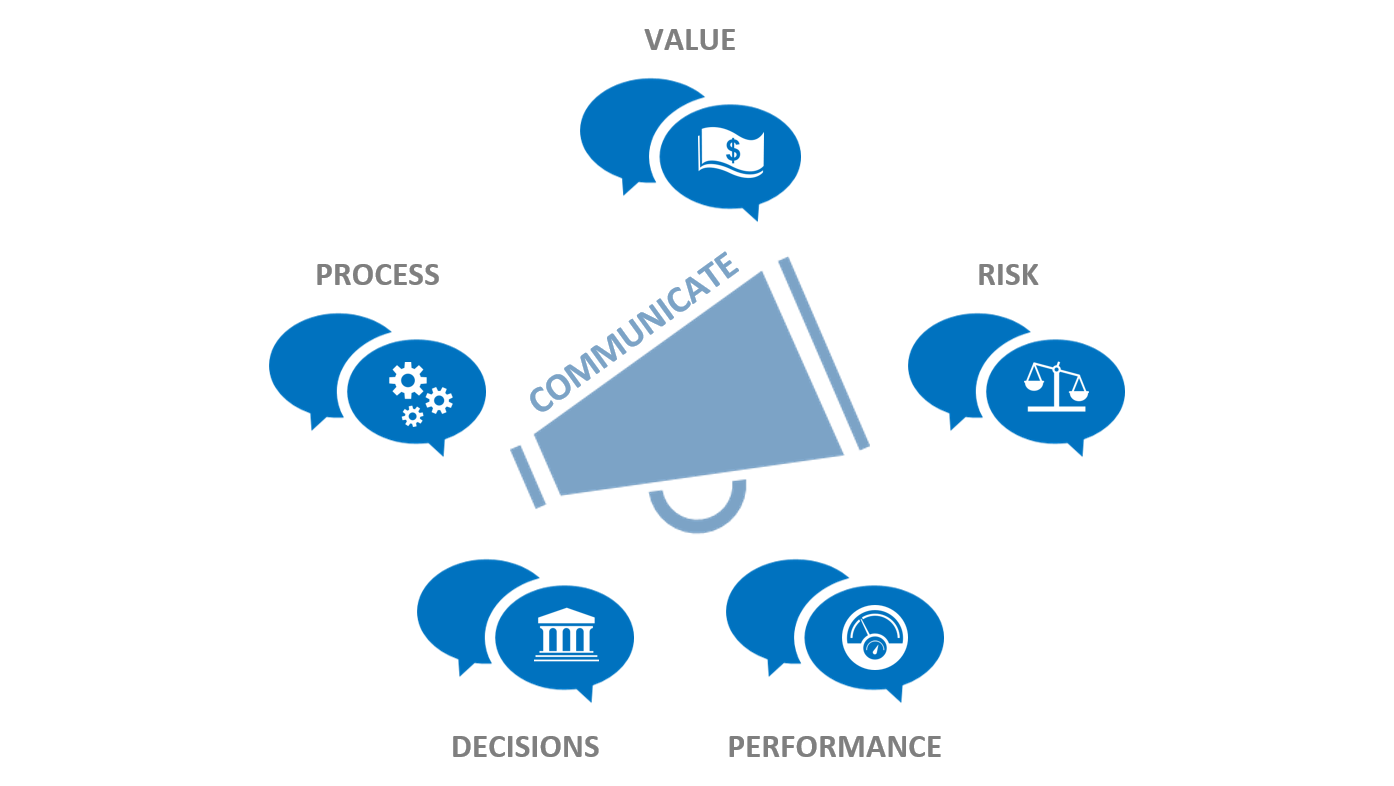
Best Practice #12: process accountability
The final best practice centers around accountability. It is important to have a Portfolio Manager or Portfolio Analyst that oversees the work intake process and can shepherd people through it. Employees will try to take the path of least resistance, and if there is no accountability in place, then users of the work intake (demand management) process will in most cases provide the minimal amount of work required to get through the process, or worse, they will go around the process entirely.
We are not recommending that you have process police to hound people over every small detail. Rather, you need personnel in place who can communicate the process, answer questions, provide support, and shepherd requests through the process. This is a necessary value-added service to make the work intake process successful.
Process accountability at the leadership level is much harder and should be handled by the sponsor of the portfolio management process. Even governance team members may not be familiar with the work intake process and may attempt to skip or avoid certain steps. If the governance team agrees to be held accountable by a Portfolio Manager (non-management), all the better; but in many cases a senior leader needs to step in to help guide the governance team to follow existing portfolio processes. Ongoing education around project portfolio management is strongly encouraged.
A final consideration: Business Relationship Managers
Business Relationship Managers (BRM’s) are growing in popularity at many organizations and have a useful function as it relates to the work intake (demand management) process. We do not categorize the use of Business Relationship Managers as a best practice, because many organizations do not have a specific need for this role. However, many large companies that utilize an enterprise project management office (EPMO) and support multiple business units or departments often find the Business Relationship Manager role to be very effective for bringing in important project requests at the right time. BRM’s are in contact with business leaders and better understand the needs of the business than an EPMO does. A Business Relationship Manager becomes a critical liaison to the business and can both communicate the intake process to the business as well as bring other important information back to them. Likewise, the BRM is in a position to help bring forward new project requests at the right time to the governance team.
Summary
Work intake is one of the most important aspects of project portfolio management, and a good intake process is one of the critical success factors for all of portfolio management. We have covered the top 12 best practices for implementing work intake (demand management). If you would like to learn more about how Acuity PPM’s Work Intake module can help your organization, click on the button below to schedule a meeting.
Tim is a project and portfolio management consultant with over 15 years of experience working with the Fortune 500. He is an expert in maturity-based PPM and helps PMO Leaders build and improve their PMO to unlock more value for their company. He is one of the original PfMP’s (Portfolio Management Professionals) and a public speaker at business conferences and PMI events.
[activecampaign form=3]
Why is a project definition important for work intake (demand management)?
The first step in setting up a work intake (demand management) process is to determine the organizational definition of a project. This definition helps define the scope of the portfolio to determine what work could be in the scope of the project portfolio or out of scope for the project portfolio. We can simplify this by defining the different between project work and non-project work (also known as operational work, “business as usual”, “keep the lights on” work, etc.). Without this definition firmly in place and well communicated, a project management team (PMO) will waste time reviewing requests that do not count as project work.
Why are project tiers important for work intake (demand management)?

Organizations will do even better if they distinguish different tiers of projects. The reason for doing this is to triage projects that are simpler, shorter, and less risky from the larger projects that need more scrutiny. Utilizing the same review process for all types of projects often results in an unnecessarily burdensome process for smaller projects and will be viewed as bureaucratic.
Why is tiered governance important for work intake (demand management)?
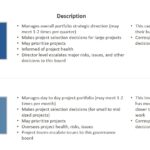
Larger organizations that have a good volume of project requests should enable a tiered-governance approach. Tiered governance is about assigning decision rights to different levels of management. For example, proposals that go through the fast-track process might be reviewed by Director-level management, where as larger strategic projects with larger budgets may be reviewed by Executive-level management. One of the major benefits of this approach is that it frees up Executive leadership to make decisions on the biggest projects undertaken by the company.
What is the #1 success factor for work intake (demand management)?
The #1 success factor for any work intake (demand management) process is to say NO to projects that do not belong in the portfolio. This is also the hardest aspect of Intake because most leadership teams say “Yes” to too many projects and overload the portfolio. This is why the Intake/demand management process is so important. Leadership teams that can say no to project requests can help control the flow of work, protect resource capacity, and ensure that the right things are done at the right time.
Never miss an Acuity PPM article
Don't take our word, listen to what others are saying:
"I find value in all of your articles."
"Your articles are interesting and I am sharing them with my team who have limited project knowledge. They are very useful."


